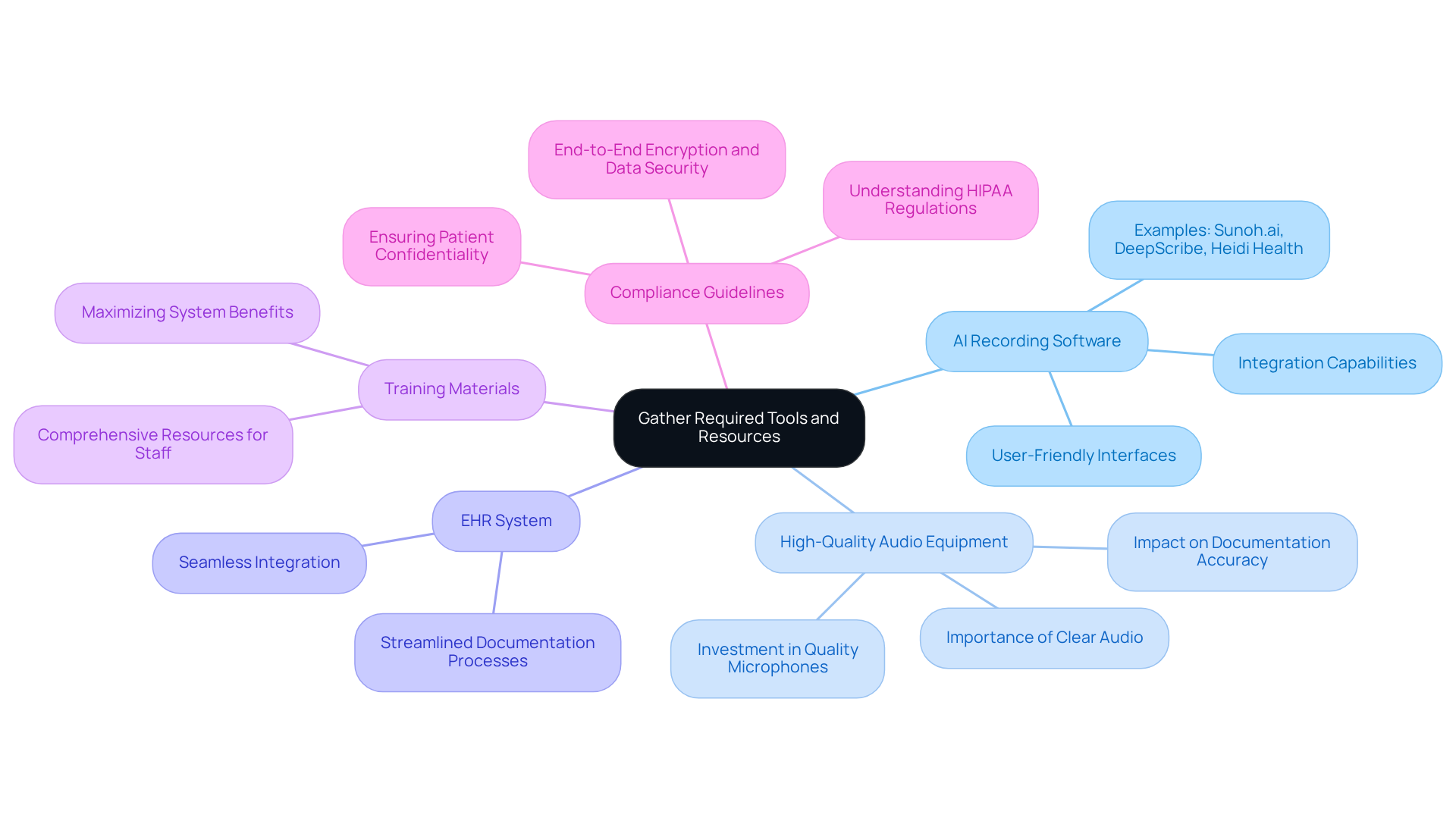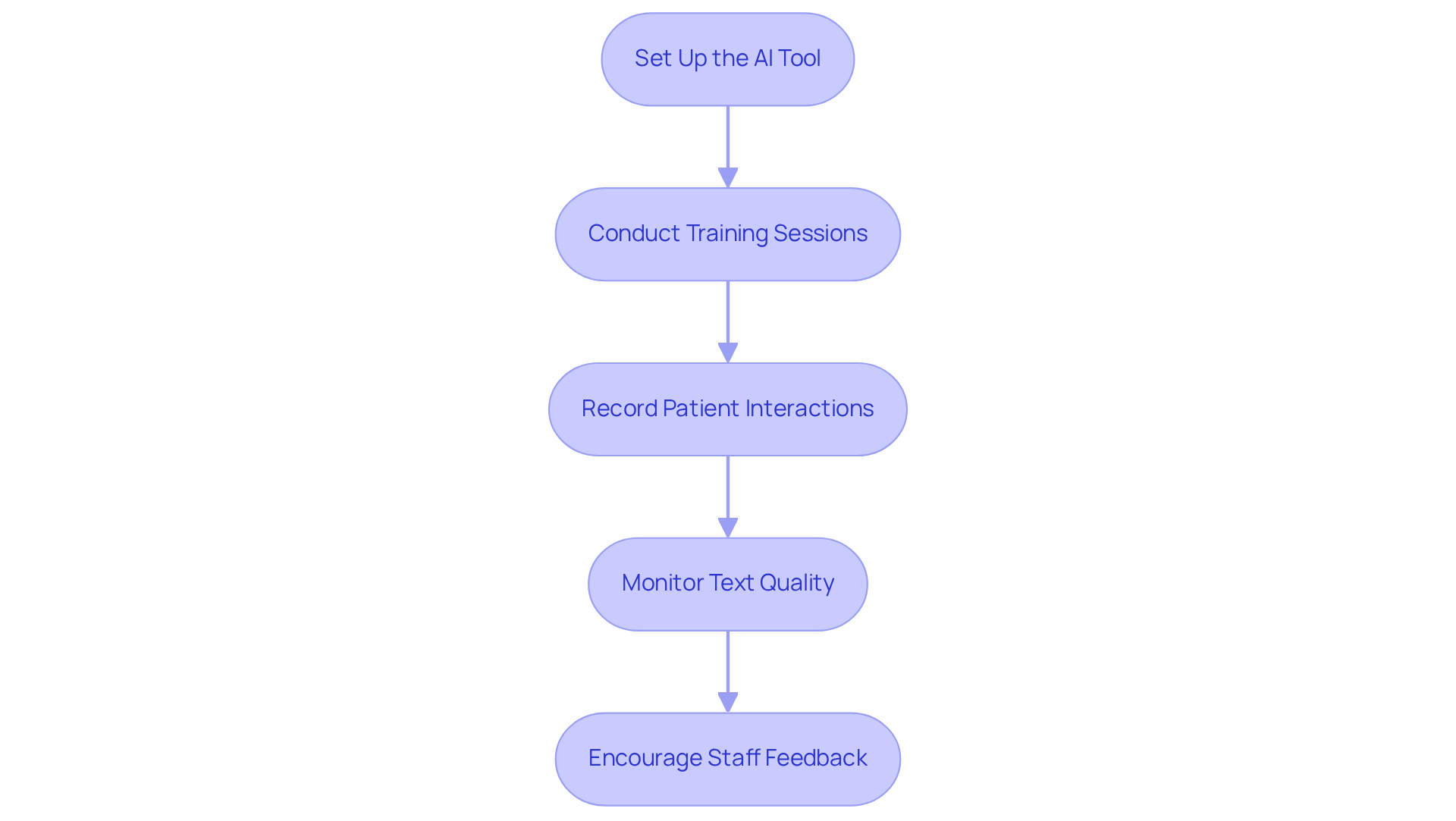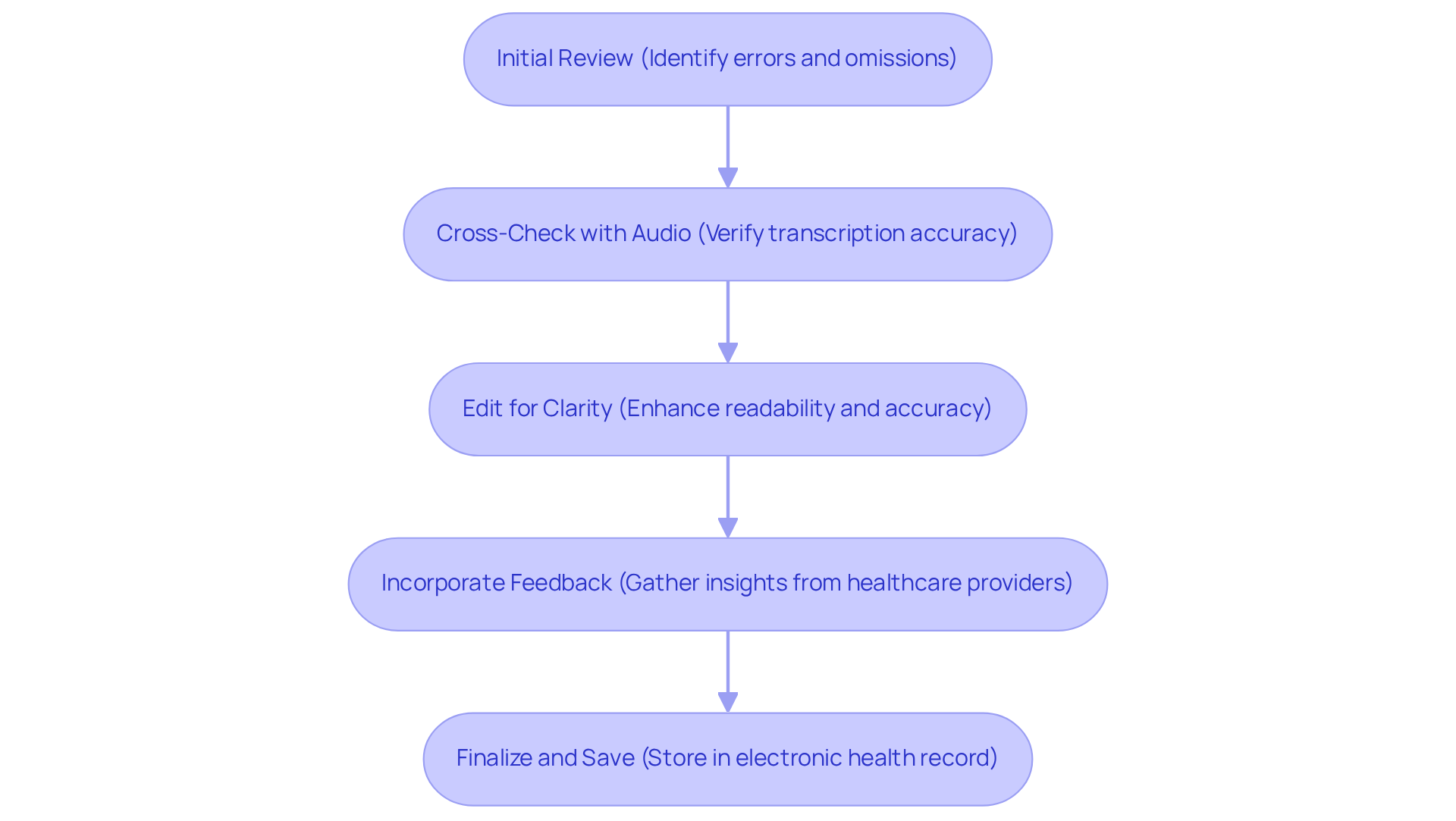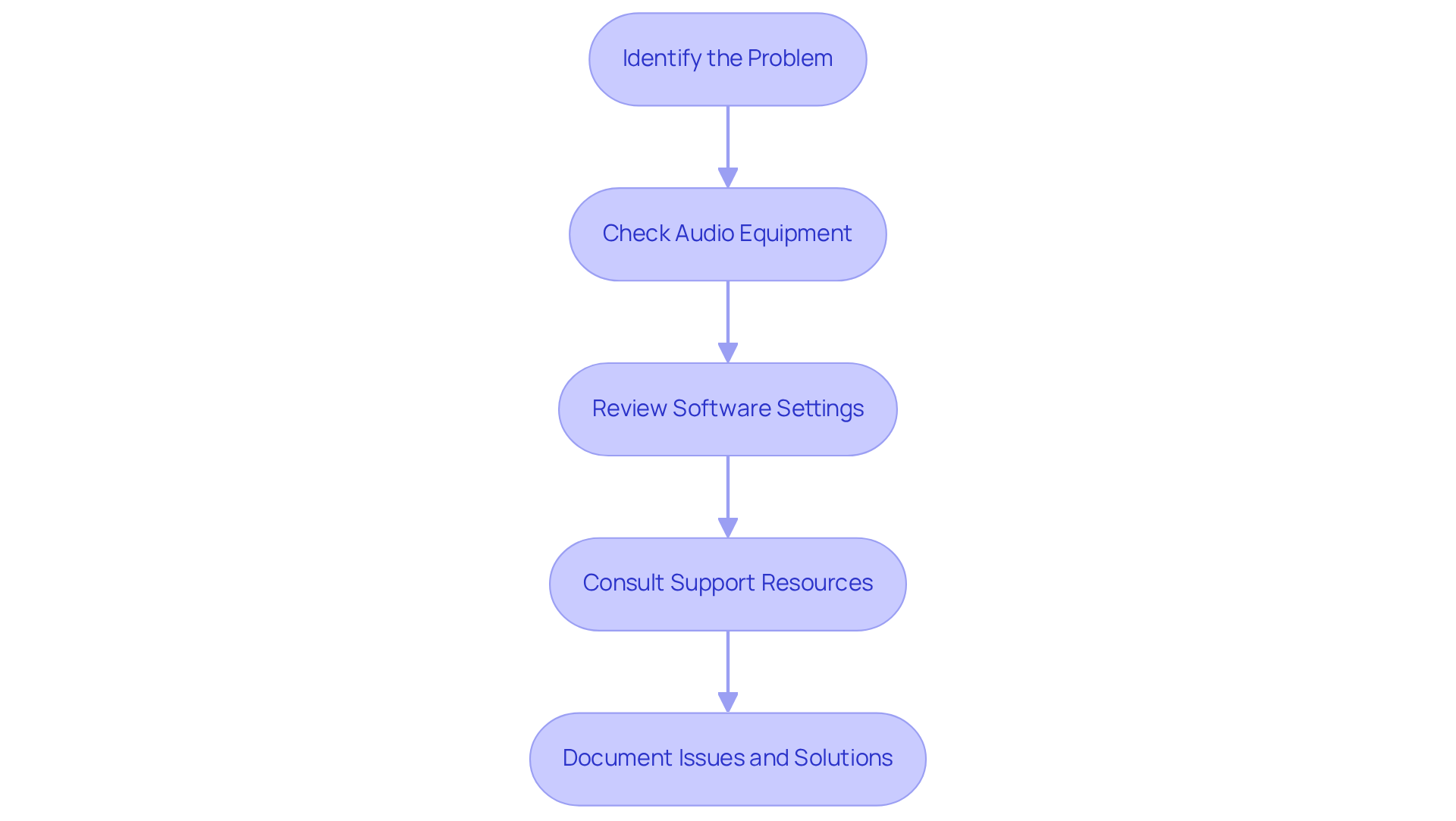Introduction
In the fast-paced world of healthcare, the emotional toll of documentation can often overshadow the primary goal: patient care. Many healthcare providers feel overwhelmed, struggling to balance administrative tasks with the need for meaningful patient interactions. This burden can lead to frustration and burnout, impacting not only the providers but also the patients who rely on their care.
Imagine a scenario where healthcare professionals can reclaim precious time, focusing more on their patients rather than paperwork. The introduction of AI transcription technologies offers a promising solution. By streamlining documentation processes, these tools can help alleviate some of the pressures that healthcare workers face daily.
However, with this promise of increased efficiency comes the challenge of ensuring accuracy and managing complex medical terminology. How can healthcare providers effectively harness AI transcription to enhance patient care while navigating these potential pitfalls?
Here are some key solutions to consider:
- Invest in training for staff to ensure they are comfortable using AI tools.
- Implement quality checks to maintain accuracy in documentation.
- Encourage feedback from healthcare professionals to continuously improve the system.
By addressing these challenges, healthcare providers can not only improve their workflow but also enhance the quality of care they deliver. The benefits of AI transcription are clear: more time for patient interactions, reduced stress, and improved job satisfaction.
Let’s explore how we can work together to embrace these technologies, ensuring that patient care remains at the forefront of our efforts.
Understand AI Transcription in Healthcare
In the demanding world of healthcare, providers often face overwhelming administrative burdens that can detract from their primary focus: patient care. Have you ever felt the weight of documentation pressing down on your ability to connect with patients? AI documentation in medical settings offers a compassionate solution, utilizing advanced technologies like natural language processing (NLP) and machine learning to transcribe medical spoken interactions into precise written records. This innovative approach can reduce the time spent on documentation by as much as 43%, allowing healthcare professionals to redirect their energy toward what truly matters—caring for patients and fostering meaningful face-to-face interactions.
For instance, hospitals that have embraced AI documentation report a significant rise in clinician efficiency. Studies reveal that physicians spend an average of 15.5 hours weekly on administrative tasks, which can account for up to 30% of their overall working hours. Imagine the relief of offloading these responsibilities, enabling more time for direct patient engagement.
The ability of AI recording systems to accurately transcribe medical terminology and contextual nuances is vital for effective implementation. Recent advancements in AI text conversion technology have led to impressive precision, with specialized platforms achieving over 99.9% accuracy—far surpassing traditional methods. Yet, challenges remain, particularly in managing complex medical terminology, which can lead to recording inaccuracies. Addressing these challenges is essential for enhancing AI documentation in clinical environments, particularly in how to transcribe medical information, ensuring that medical practitioners can maintain effective communication with their patients.
Healthcare leaders are increasingly recognizing the benefits of AI documentation in improving care quality and alleviating physician burnout. Approximately 92% of medical leaders believe that automation can help ease staffing shortages, considering AI documentation tools essential to transcribe medical records efficiently and enhance patient-centered care. By alleviating administrative burdens, healthcare professionals can devote more time to direct patient care, ultimately elevating the quality of care provided.
As we move forward, let’s embrace these advancements together. How can we further support each other in navigating these changes? The journey toward improved patient care is one we can take together, fostering a healthcare environment where compassion and efficiency go hand in hand.

Gather Required Tools and Resources
Implementing AI transcription can feel overwhelming, especially when you're already juggling so many responsibilities. But with the right tools and resources, you can ease some of that burden and focus more on what truly matters—your patients.
-
AI Recording Software: Start by selecting a reliable AI recording tool tailored to your practice's needs. Options like Sunoh.ai, DeepScribe, and Heidi Health stand out for their user-friendly interfaces and seamless integration capabilities. For instance, Sunoh.ai uses ambient-listening technology and natural-language processing, which can significantly enhance the accuracy and efficiency of your recordings.
-
High-Quality Audio Equipment: Don’t underestimate the importance of clear audio. Investing in quality microphones and recording devices is crucial for capturing client interactions effectively. Remember, poor sound quality can lead to documentation errors that may affect patient care. As the saying goes, 'Good documentation relies on both technology and skilled individuals.' This highlights the necessity of having the right equipment.
-
Electronic Health Record (EHR) System: Ensure that your AI recording tool integrates smoothly with your existing EHR system. This integration not only streamlines documentation processes but also boosts overall efficiency in managing patient records.
-
Training Materials: Equip your staff with comprehensive training resources to help them get acquainted with the AI recording tool and its features. Effective training is key to maximizing the benefits of systems that transcribe medical documentation and ensure accuracy. Did you know that doctors can save about an hour each day that was previously spent typing notes? This statistic underscores the efficiency gains from proper implementation.
-
Compliance Guidelines: It's vital to understand HIPAA regulations and ensure that your chosen tools comply with these standards to protect patient confidentiality. Compliance is essential for maintaining trust and safeguarding sensitive information. Additionally, opt for vendors that offer end-to-end encryption and secure data transfer to enhance data security.
By taking these steps, you can alleviate some of the administrative burdens that often distract from patient care. Remember, you’re not alone in this journey—many healthcare providers face similar challenges. Embrace these tools and resources to create a more efficient and compassionate practice.

Implement AI Transcription for Medical Conversations
While implementing AI to transcribe medical conversations can feel overwhelming, it doesn’t have to be. By following these essential steps, you can ease the administrative burden and focus more on what truly matters—your patients.
-
Set Up the AI Tool: Start by installing and configuring your chosen AI recording software. Make sure it integrates smoothly with your electronic health record (EHR) system. This integration is crucial for efficient data management, allowing you to streamline your workflow.
-
Conduct Training Sessions: It’s vital to organize thorough training for all staff members who will use the AI tool. Focus on operational procedures and best practices for dictation. Remember, successful training often includes hands-on practice and ongoing support, reinforcing what everyone learns.
-
Record Patient Interactions: During consultations, use the AI tool to capture conversations. Prioritize high audio quality; clear recordings are essential for accurate documentation and effective record-keeping.
-
Monitor Text Quality: Regularly check the outputs generated by the AI tool to ensure they meet your practice's standards. Providing constructive feedback to the AI system can help improve its precision and reliability over time.
-
Encourage Staff Feedback: Create a feedback loop where staff can share challenges or suggest improvements regarding the AI text conversion process. This not only fosters a culture of continuous improvement but also ensures that the tool evolves to meet your practice's needs effectively.
By taking these steps, you can transform the way your practice transcribes medical documentation, ultimately enhancing the care provided to patients. How can you start implementing these changes today?

Review and Refine Transcriptions for Accuracy
To ensure the accuracy of AI-generated transcriptions and enhance patient care through innovative solutions, consider these essential steps:
-
Initial Review: Start with a thorough initial review of the AI-generated text. This helps identify any obvious errors or omissions that could affect overall quality. Tackling these administrative challenges is vital, especially in a sector that often resists innovation.
-
Cross-Check with Audio: Actively listen to the recorded audio while reviewing the written text. This verification process is crucial for ensuring that all information is transcribed medically accurately. With AI recording platforms averaging only about 61.92% accuracy, this step addresses significant challenges in healthcare as it seeks to transcribe medical documentation effectively.
-
Edit for Clarity: Make necessary edits to enhance clarity and readability. Ensure that medical terminology is accurately represented. Misinterpretation of jargon can significantly impact care. Common mistakes in AI-generated text include mislabeling speakers and failing to capture context, which can lead to misunderstandings. Aim for concise phrasing to improve communication efficiency.
-
Incorporate Feedback: Gather input from healthcare providers who interacted with the individual. Their insights can enhance the written record, ensuring it accurately reflects the nuances of the conversation. As Rick Orford points out, 'Human writing precision: ~99%.' This highlights the importance of human supervision and teamwork in improving experiences for individuals.
-
Finalize and Save: Once you’re satisfied with the accuracy and clarity, complete the document and store it in the individual's electronic health record. This guarantees adherence to documentation standards and preserves a dependable record for future reference, ultimately enhancing medical service delivery.
By following these practices, healthcare providers can significantly minimize common mistakes associated with how they transcribe medical records generated by AI. This not only improves the quality of patient documentation but also addresses the urgent challenges within the healthcare system.
How can you implement these steps in your practice to enhance patient care?

Troubleshoot Common Transcription Issues
To effectively troubleshoot common transcription issues, it’s important to approach the process with care and understanding when you transcribe medical documents. Here’s how you can navigate these challenges:
-
Identify the Problem: Start by evaluating whether the issue stems from audio quality, software glitches, or text conversion errors. Recognizing the root cause is crucial for finding the right solution.
-
Check Audio Equipment: Make sure your microphones and recording devices are working well. Research indicates that poor audio quality can significantly impact the accuracy of recordings, highlighting the importance to transcribe medical data correctly to avoid mistakes that could affect patient care. For example, a GP’s comment, ‘No chest pain today,’ was mistakenly transcribed medical as ‘Chest pain today,’ resulting in an unnecessary cardiology referral.
-
Review Software Settings: Ensure that your AI transcription software is properly configured and up to date. Correct settings can greatly enhance performance and accuracy. Keep in mind that AI-generated text can sometimes sound fluent yet be misleading—what experts refer to as ‘authoritative but incorrect.’
-
Consult Support Resources: Don’t hesitate to utilize the support resources from your AI tool’s manufacturer. FAQs, user manuals, and customer support can provide valuable insights for resolving specific issues.
-
Document Issues and Solutions: Keep a log of recurring problems and their solutions. This practice not only streamlines troubleshooting for future occurrences but also empowers your team to resolve issues more efficiently. By reducing administrative burdens, you can help lower burnout rates among healthcare staff, allowing them to focus more on what truly matters—transcribe medical information and provide patient care.
By taking these steps, you can create a more efficient workflow that ultimately benefits both healthcare providers and patients. Remember, you’re not alone in facing these challenges; support is available, and together we can improve the quality of care.

Conclusion
The integration of AI transcription in healthcare marks a significant shift, easing the administrative burdens that often weigh heavily on healthcare providers. This shift allows them to dedicate more time to what truly matters: patient care. By harnessing advanced technologies like natural language processing and machine learning, medical professionals can drastically cut down on documentation time, leading to enhanced efficiency and improved quality of care for patients.
Have you ever felt overwhelmed by paperwork? You're not alone. Throughout this article, we’ve explored essential insights, such as the importance of choosing the right AI tools, ensuring high-quality audio for accurate transcriptions, and the necessity of ongoing training and feedback to refine the transcription process. The statistics showcasing potential time savings and accuracy improvements highlight the undeniable value of adopting AI solutions in medical settings. Additionally, addressing common transcription challenges through careful troubleshooting can further boost the effectiveness of these tools.
Embracing AI transcription goes beyond merely adopting new technology; it’s about nurturing a healthcare environment that prioritizes patient interaction and care quality. As healthcare providers embark on this journey, the collective effort to implement and refine these systems will ultimately foster a more efficient and compassionate practice.
Key Solutions to Consider:
- Select the right AI tools for your needs.
- Ensure high-quality audio for better accuracy.
- Commit to ongoing training and feedback.
Taking action today to integrate these tools can pave the way for a brighter future in healthcare, where technology and human connection work hand in hand for the benefit of all. Let’s work together to create a healthcare landscape that truly values both efficiency and compassion.




